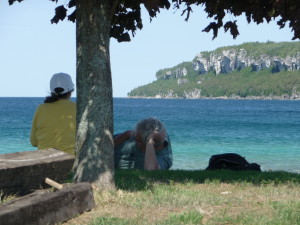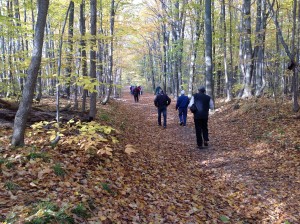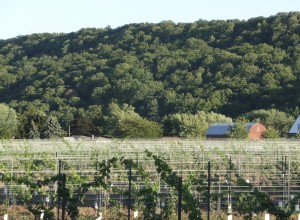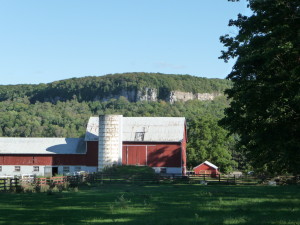The Niagara Escarpment
Sacred Space
Presented at the Leading Edge Conference 2011
“Sustainable Tourism and Economic Development
in the Niagara Escarpment Biosphere Reserve.”
By Don Alexander, Commissioner, Niagara Escarpment Commission
The Niagara Escarpment is one of 562 Biosphere Reserves in the World. When the UNESCO MAB programme convened an International Workshop on the Importance of Sacred Natural Sites for Biodiversity Conservation, Biosphere Reserves were represented from all parts of the world EXCEPT North America and Western Europe. (1)
The distinction is made that “In many non-western societies traditional sacred areas fulfill functions similar to those of legally protected areas in “the west”. (1)
In traditional cultures the sacred is recognized in forests, individual trees, forest groves, waterfalls, springs, caves, prominent heights, glens and trails.
Consideration of the Niagara Escarpment as Sacred place strengthens the conservation ethic among growing numbers of people.
There is increasing opinion that a “sacred” out of the ordinary dimension will be necessary to give the environment the priority it needs to cope with pressures on the entire biosphere system.
The Escarpment area is rich in the very kind of place, which in traditional cultures , are recognized as sacred. The way many people– both visitors and local residents—relate to the escarpment, is in the realm of “the sacred”. They frequently claim a special and personal relationship with a particular place along the escarpment. People will describe a feeling of awe or wonder in some vista or rock structure. Some will say it is a place they go to be contemplative; that there is a different order of time as they hike along the trails.
Some will then venture to say they have a special place that for them is sacred…or indeed that the escarpment ridge and its natural areas is a total sacred expression.
Eliade in “The Sacred and the Profane” (2) notes that “The modern westerner experiences a certain uneasiness before many manifestations of the sacred; finds it difficult to accept the fact that for many human beings the sacred can be manifested in stones or trees…we become aware of the sacred because it manifests itself, shows itself as something wholly different from the profane.”
In Eliade (2) the first possible definition of the sacred is that it is the opposite of the profane. There is a boundary between the sacred and the profane (or everyday).
Perhaps we can begin to think that the boundary established in the Niagara Escarpment Planning and Development Act (NEPDA) has become a boundary –as in Eliade—setting aside a place separate from the everyday…as a “sacred” place.
At the Niagara Escarpment Commission meetings–despite a reluctance to talk of the sacred– many people have related a special experience or identify a place or time that has had an emotional impact on them. At escarpment hearings people will speak eloquently about their reasons for wanting to protect an area. Escarpment features that draw special attention are like the list of sacred sites on other continents; heights, sacred trees, waterfalls, caves, prominent land-forms, etc
The dry and practical exercise of protection as described in regulations and legislation is suddenly charged with protecting the natural place and the future of the community Changing a watercourse or blasting rock is described –often by writers, and poets — in terms of hurt or harm that is done to the person or community or to “mother earth”.
“If they blow a hole in the backbone
The one that runs across the muscles of the land.
We might get a load of stone for the road
But I don’t know how much longer we can stand”
Escarpment blues, Sarah Harmer. (used with permission)
Looking back forty years, the establishment of the Niagara Escarpment legislation was–in part–a response to a shared sense of community values, that the area was special, “out of the ordinary” and had about it what some would, even then, call a sense of the sacred.
Many environmentalists consider that for the environmental movement to be effective it will “require the power of great conviction and strong emotional force. …Ecological facts and figures cannot sufficiently motivate us for the psychological transformation that has to come about” ( 4, Devereux p 17) ,
and
“As scientific understanding has grown, so our world has become dehumanized …and we have lost our emotional ‘unconscious identity’ with natural phenomena” (Jung p 95).
Emerging deep ecology or ecopsychology speaks to and assumes those emotional dimensions.
The Niagara Escarpment, in that it evinces, these senses of awe, serenity and the sacred becomes a physical icon for the environmental movement to move toward that new level of deep ecology and ecopsychology. As such it will become a true “natural resource”.
The aboriginal presence is in evidence along the Niagara Escarpment in archaeological findings and in oral history. Near the northern extent of the Niagara Escarpment area a sacred site, Nochemowenaing was recently set aside. The sacred small peninsula has a history as a sacred birthing and healing place. An offshore whirlpool is related to the Ojibway creation.
In a hearing officer’s report to preserve the sacred site of Nochemowenaing from cottage-lot developments, the word sacred , for the first time, makes its way into considerations of the Niagara Escarpment plan:
The Hearing Officers (2008) found that:
“even though the term ‘culture” in the Niagara Escarpment Plan is linked to human made manifestations of cultural activities, there can be a spiritual or sacred aspect of the cultural heritage features sought to be maintained or conserved and therefore, in this regard, spiritual or sacredness considerations can be taken into account in the decision making process under the Niagara Escarpment Planning and Development Act.” (9)
Nochemowenaing is just across the water from Neyaashiinigmiing (Cape Croker).
The indigenous names have been reinstated from the settler map-makers impositions. (See United Nations Declaration on the Rights of Indigenous Peoples Article 14 on retaining and designating names for communities, places and persons.)
We might now ask: was the establishment of the Niagara Escarpment planning area and legislation in the 1970s, a response to some innate sense of “sacred value”?
Much of the natural escarpment area, was undisturbed because road building and house construction did not have the equipment –until mid 20th century—to venture easily into the escarpment area. By the time it became possible to assault the escarpment there were defenders in the hiking, environmental and-naturalist camp. Their concerns led to the studies that helped establish the escarpment land use plan.
Areas of the escarpment were being defended with the zeal that other cultures would use to protect a sacred site.
(There was finally what some would call a miracle. That all three political parties then sitting in the Ontario legislature agreed on something —and continue to agree that the Escarpment deserves the special protection and attention it receives through the Niagara Escarpment legislation and regulations.)
The Bruce Trail was a strong influence in the formation of the Niagara Escarpment Plan.
The Bruce Trail may never be steeped in the history of pilgrimage or sacred destinations .such as world famous pilgrimage trials like the Camino de Santiago in Spain, the trail to Machu Picchu in Peru or the sacred mountains of China.
However,
Walking in its own right has transformative and some would say sacred moments. Arthur Paul Boers who wrote “The Way is Made by Walking” about the Camino de Santiago, the pilgrimage trail in Spain, made these remarks in a CBC programme :(7)
“I was stunned by the beauty….I noticed when I did long distance walking that time moved very differently, that time slowed down. The final thing that struck me ; as I walked it got me away from my regular routine. It got me to think about how I was leading my life and would help me to recognize how my life was getting off balance….but being on the trail got me re-centred and recommitted to my most important priorities.”
Paul Boers, was talking in that interview, not about the Spanish trail he wrote about, but about his first experiences of walking distances; hiking here, on the Bruce Trail. He was born in St Davids , a Niagara Escarpment community in the Niagara Peninsula.
When we turn our thoughts to the sacred place, we can also think of revisioning aspects of tourism and the Niagara Escarpment as a destination for visitors
Rupert Sheldrake in “The Rebirth of Nature” describes an expanded richness in the “tourist” experience; moving from tourism to pilgrimage:
“Although the spirits of places elude analysis in terms of mechanistic science, their importance is implicitly recognized by tourists who visit famous sites because of their particular qualities and histories…the primary factor in pilgrimage is intention…we can inform our intention by learning the stories of the place and its spirit, and by hearing of other peoples experiences there. I believe that much good would flow from a change of attitude whereby tourists became pilgrims once again.” (3) p180
Jeremy Rifkin in The Empathic Civilization (10) introduces the phrase “biosphere consciousness”. It links ecology, biosphere, and a sense of our interconnectedness with others, with all of nature and the sense of sacredness and wonder that many people experience. The word “biosphere” takes on added meaning.
.Because of the escarpment’s relationship as part of the UNESCO Biosphere Reserve programme we –people of the Niagara Escarpment–can become particularly aware and sensitive to the potential of the term “biosphere consciousness”
“A biosphere consciousness has begun. A realization that daily consumption of energy and other resources ultimately affects the lives of every other human being and every other creature that inhabits the earth.” (10a)
In summary. We set out to consider the Niagara Escarpment as Sacred Place. We recognized people from time to time saying they have a sacred place or experience. We were informed by the knowledge that on other continents, traditional sacred sites are often biosphere reserves.
When we do not deny the sense of sacred in our natural spaces we discover a rich vein of thoughtful writing and texts about the validity of the sacred in conservation planning, pilgrimage, trekking and vacationers. Ultimately we secure the knowledge that “biosphere consciousness” will equip our environmental movement to be effective with the onerous tasks ahead of us.
Simon Schama in Landscape and Memory provides a summary statement: (5) p14
“….. notwithstanding the assumption…. that Western culture has evolved by sloughing off its nature myths , they have in fact never gone away….., (O)ur entire landscape tradition is the product of shared culture, it is by the same token a tradition built from a rich deposit of myths, memories and obsessions. The cults which we are told to seek in other native cultures –of the primitive forest, of the river of life, of the sacred mountain—are in fact alive and well and all about us if only we know where to look for them.”
We have looked along the Niagara Escarpment…and found them-
-0-
(1) UNESCO-MAB, The Importance of Sacred Natural Sites for Biodiversity Conservation, proceedings of conference, People’s Republic of China, UNESCO-Paris 1993
( 2) Eliade, Mircea ,The Sacred and the Profane , Harcourt-Brace (Eng. Trans.) 1959
(3) Sheldrake, Rupert, The Rebirth of Nature, The Greening of Science and God Bantam 1991
(4) Devereux, Paul, Re-Visioning the Earth, New York , Simon and Schuster (Fireside)1996
(5) Schama, Simon, Landscape and Memory, Vintage Canada, 1996
(6) Roszak, Gomes & Kanner (Editors) , Ecopsychology, Sierra Club Books, 1995
(7) Tapestry, Canadian Broadcasting Corporation, interview with Paul Arthur Boers, podcast June 6, 2010 ( Boers, Arthur Paul , The Way is Made by Walking, Downers Grove Illinois, Inter Varsity Press ,Formatio, 2007)
(8) Suzuki, David, Sacred Balance, Vancouver, Greystone Books , Revised 2007
(9) Niagara Escarpment Hearing Office, Notice of Decision Aug 7, 2008, Renchko & Hunter vs NEC. re (Nochemowenaing)
(10) Rifkin, Jeremy, The Empathic Civilization, Penguin Group, 2009
(10a) Rifkin, Jeremy ,blog post re The Empathic Civilization, posted Jan. 2010
(11) Taylor, Charles, A Secular Age, Harvard University Press, 2007
(12) Jung, C. G. , Man and His Symbols, Aldus Books, London, 1964
(13) United Nations Declaration on the Rights of Indigenous Peoples
article 14)




